Makavejev’s film gets both its name and much of its footage from a remarkable “lost” melodrama of which many had heard but which no one had seen in 1960s Belgrade. The original Innocence Unprotected was the first talkie made in Serbia, and it was written, directed, and produced by Dragoljub Aleksić, an irrepressibly self-assured and self-promoting acrobat, strongman, and escape artist. Having begun to film his feats of strength before World War II, he decided in 1942 to incorporate the footage into a feature film in which he would star as himself, showing off his prowess while rescuing a damsel in distress—an orphan named Nada. Hence, as Greenspun puts it, “Rather a lot of the old movie is given over to Nada’s reveries on the prowess of her hero, each reverie accompanied by appropriate footage showing Aleksić breaking chains, balancing on monuments or hauling hundreds of pounds in weights or people high above the city by means of his wonderful teeth.”
Banner stills L to R: Innocence Unprotected, courtesy Dušan Makavejev; Reminiscences of a Journey to Lithuania, courtesy Anthology Film Archives
Innocence Unprotected (Nevinost bez zaštite)
Dušan Makavejev, Serbia, 1968, 35 mm, subtitles, 79 minutes
When Innocence Unprotected opened in New York in 1971, Roger Greenspun of the New York Times suggested that it was “different enough from any other movie you are likely to have seen to deserve some special explanation.” This description points to how truly remarkable Dušan Makavejev’s (b. 1932) madcap masterpiece is—to surprise a cineaste in the early 1970s was surely no small feat.
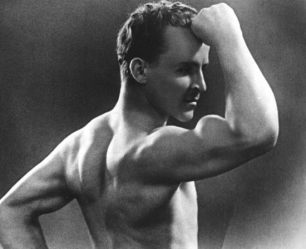
Still from Innocence Unprotected, courtesy Dušan Makavejev
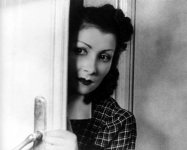
Still from Innocence Unprotected,
courtesy Dušan Makavejev
Remarkably, Aleksić and his collaborators decided to make their film amid the Nazi occupation of Belgrade, which lasted from 1941 until 1944. Against all odds, the actors and crew succeeded, only to see the film banned first by the Nazis soon after its premiere and then suppressed after the war by the Communist authorities, who suspected Aleksić of being a collaborator and war profiteer. He continued to be shunned from public life even after the charges against him were dropped in 1945. His film was not shown again for 26 years after its wartime premiere.[1]
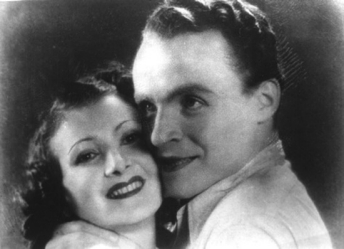
Still from Innocence Unprotected, courtesy Dušan Makavejev
Lorraine Mortimer, author of Terror and Joy: The Films of Dušan Makavejev, describes in detail how for his film, Makavejev borrowed the older one almost in its entirety, intercutting fictional scenes with documentary footage made during the occupation by Stevan Misković, the cinematographer (and only professional crew member) of the original Innocence Unprotected. Makavejev also hand-tinted certain frames and added period newsreel and propaganda footage, portions of other fiction films (such as Grigory Alexandrov’s 1935 Soviet musical The Circus), and new footage of interviews with the actors from the original film, including, most prominently, Aleksić himself.[2] In 1968, the aging strongman still had all the bravado of his younger days; for the opening of Makavejev’s film, at 61, he performed anew an old stunt called the “Pillar of Death.”
Makavejev made Innocence Unprotected after the international success of his two earlier films, Man Is Not a Bird (1965) and Love Affair, or the Case of the Missing Switchboard Operator (1967). Both contained smatterings of found footage, but Innocence Unprotected made it central to the story. The extensive borrowing came about because, according to Makavejev, the older film “had everything: suffering, love, conflict, rape, humor.” Makavejev also admired its technical ingenuity: “Seventeen years before Godard’s first feature and Hiroshima mon Amour, Aleksić integrates in his story film sequences of actuality. . . . The document is incorporated with fiction, and becomes the climactic point of the fiction.” Commenting on the peculiar emotional power of the older film, Makavejev wrote, “The film is naïve and cruel at the same time; primitive make-up is constantly being mixed with real blood and tears."[3]
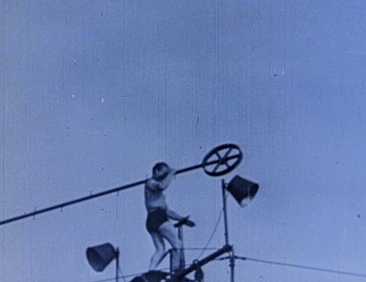
Still from Innocence Unprotected, courtesy Dušan Makavejev
The combination of the ridiculous and tragic that he saw in the older film resonated with Makavejev’s own childhood experience of World War II in Belgrade, where he witnessed German bombings and endured the privations of occupation.[4] He has said that his aesthetic sensibilities have their beginnings in that period. “He tells of himself as a boy, exploring Belgrade streets as the war’s end was announced, seeing stacked corpses of Hitler’s defeated infantrymen on the sidewalks, as joyous Yugoslavs danced victoriously in the streets beside the dead. Makavejev says he was strongly influenced by such ridiculous, blackly humorous juxtapositions that war produces abundantly."[5]
It was also as a child that Makavejev fell in love with cinema. He was exposed to a broad array of films ranging from Hollywood comedies, British documentaries, and Soviet cinema to the films of Jean Vigo and the New American Cinema of the 1960s, the last two being especially influential on him.[6] Thus well versed in world cinema, Makavejev seems early on to have understood its power to shape reality. “The greatest gifts,” he has said, “were the years and moments that made us believe that films could change the world for the better; the worst thing was to see the world emulate the ugliest schemes and prophecies from B-movies."[7]
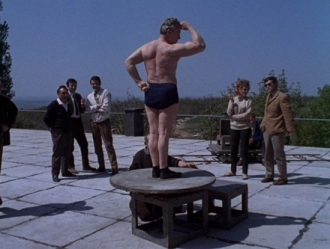
Still from Innocence Unprotected, courtesy Dušan Makavejev
With Innocence Unprotected, Makavejev tries to change the world for the better by taking “an adventurous trip into publicly nonexisting parts of Serbian national history.”[8] In this history, he clearly admires the larger-than-life hero who lives by his own rules and resists political oppression through art (even if in Aleksić’s case, unlike Makavejev’s, the political effect of Innocence Unprotected was inadvertent). In Aleksić, Makavejev finds a liberated (if comically libido-driven) hero who defies restrictive social norms imposed by any system. Aleksić’s film, according to Makavejev, was “a rebellion of the illiterate, a kind of bravery. . . . He was working against all presuppositions: if you are not educated, you never make [a] movie; if you are under the Occupation, you do not do any cultural work; if you do something for profit, it cannot result in anything intellectual, especially if you are not an intellectual.”[9] Makavejev, one suspects, identifies with Aleksić personally, especially given that Makavejev’s path to cinema also started with making amateur films, which he created in the 1950s while studying for a psychology degree and for which he almost immediately got in trouble with the authorities. (Two of Makavejev’s early films are part of this film series.)
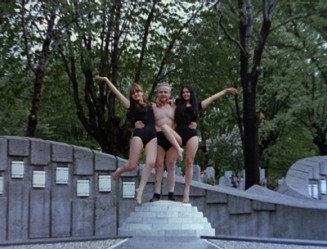
Still from Innocence Unprotected, courtesy Dušan Makavejev
In addition to offering a different kind of historical hero in Innocence Unprotected, Makavejev also offers a dramatically new and distinctive cinematic take on history. The film sardonically questions the straightforwardly triumphalist historical tropes of Marshal Tito’s Yugoslavia, whose powerful national mythology was born out of World War II.[10] As an alternative, Makavejev offers a history that is anything but straightforward.[11] It is nonlinear, messy, and based on resplicing and reediting of seemingly incongruous elements, much like the film in which it is being depicted. It is also full of unresolved trauma and bound up in the ambivalent emotions of the individuals who lived through it. Although the film does not “debunk” the basic facts of history—the Serbs are still the heroes, the Germans still the villains, and the “unprotected innocence” of the title can refer to Serbia as much as Nada—the film does show, as one scholar has put it, “a kind of ironic humility regarding historical ‘truth,’” thus escaping from “the straitjacket of narrative history.”[12]
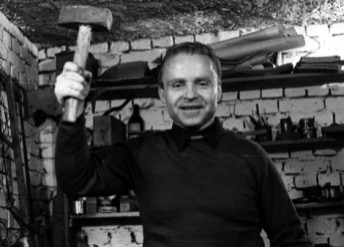
Still from Innocence Unprotected, courtesy Dušan Makavejev
After making Innocence Unprotected, Makavejev went on to create his most famous film, WR: Mysteries of the Organism (1971),[13] and was afterward “encouraged” by the Yugoslav authorities to go into exile while making his next film, Sweet Movie (1974), which, like his earlier films, featured wild juxtapositions of “found” historic “fact” and scripted “fiction.”[14] Notably, Makavejev’s take on his exile (which lasted until 1988) was as irrepressible as Aleksić’s attitude was toward his historical vicissitudes. In a 1975 interview with Roger Ebert, Makavejev still insisted—having found little success with the capitalist way of financing films—that “the Yugoslavian system is good for filmmakers.” When asked, “What about Sweet Movie,” which was banned in Yugoslavia, he mused, “The system is good . . . but I am too much.” — Ksenya Gurshtein
With thanks to Dušan and Bojana Makavejev and George Watson and the British Film Institute for making a screening of this film possible in Washington. With thanks also to Brian Belovarac at Janus Films, Jon Mulvaney at the Criterion Film Collection, and Miodrag Milošević, Head of the Academic Film Center at the Student City Cultural Center (Akademski Filmski Centar Dom Kulture Studentski Grad), Belgrade, for their help in our research of the film.
1. For a detailed history of the film’s creation and fate, see Lorraine Mortimer, Terror and Joy: The Films of Dušan Makavejev (Minneapolis, 2009), 130–31, 135–36. (back to top)
2. Lorraine Mortimer, Terror and Joy: The Films of Dušan Makavejev (Minneapolis, 2009), 130. (back to top)
3. Lorraine Mortimer, Terror and Joy: The Films of Dušan Makavejev (Minneapolis, 2009), 133, 135. (back to top)
4. Lorraine Mortimer, Terror and Joy: The Films of Dušan Makavejev (Minneapolis, 2009), 2. (back to top)
5. Lorraine Mortimer, Terror and Joy: The Films of Dušan Makavejev (Minneapolis, 2009), 125. (back to top)
6. Lorraine Mortimer, Terror and Joy: The Films of Dušan Makavejev (Minneapolis, 2009), 8. (back to top)
7. Lorraine Mortimer, Terror and Joy: The Films of Dušan Makavejev (Minneapolis, 2009), 1. (back to top)
8. Lorraine Mortimer, Terror and Joy: The Films of Dušan Makavejev (Minneapolis, 2009), 142. (back to top)
9. Lorraine Mortimer, Terror and Joy: The Films of Dušan Makavejev (Minneapolis, 2009), 131. (back to top)
10. This, however, should not necessarily be confused for a lack of enthusiasm or patriotism about his country. As Richard Byrne notes, “Makavejev has talked a great deal in interviews about his Yugoslav identity. He offered my favorite expression of it in 1991, just as the country plunged into war. In an interview with journalist Mark Thompson, later published in that author’s travelogue, A Paper House, Makavejev sits in the lobby of a Belgrade hotel, talking about the ending of WR: As Makavejev gathered his papers I put my last question. Did he agree that Milena’s failure to humanize her Soviet lover was a prophecy of the failure of a ‘third way’ between West and East? His eyes popped. ‘But I believed there is a third way, and the third way is Yugoslavia!’” (back to top)
11. For more on this, see Ewa Mazierska, “Makavejev’s Uses of History in Innocence Unprotected, Sweet Movie and Gorilla Bathes at Noon,” Studies in Eastern European Cinema 5, no. 1, Special Issue: Dušan Makavejev (2014): 16–30. (back to top)
12. Lorraine Mortimer, Terror and Joy: The Films of Dušan Makavejev (Minneapolis, 2009), 151. (back to top)
13. As Richard Byrne writes, “WR’s scathing anti-authoritarianism did not escape the attentions of the authorities. Most countries in the Soviet bloc banned it outright. Yugoslav officials suppressed the film by choking it with red tape and then encouraged its director to make his movies in exile.” For more on Makavejev’s exile, see Lorraine Mortimer, Terror and Joy: The Films of Dušan Makavejev (Minneapolis, 2009), 12. (back to top)
14. According to Richard Byrne, Makavejev also returned to the horrors of World War II in Sweet Movie by including footage of Nazi exhumations of the Polish victims of the Katyn massacre. (back to top)
